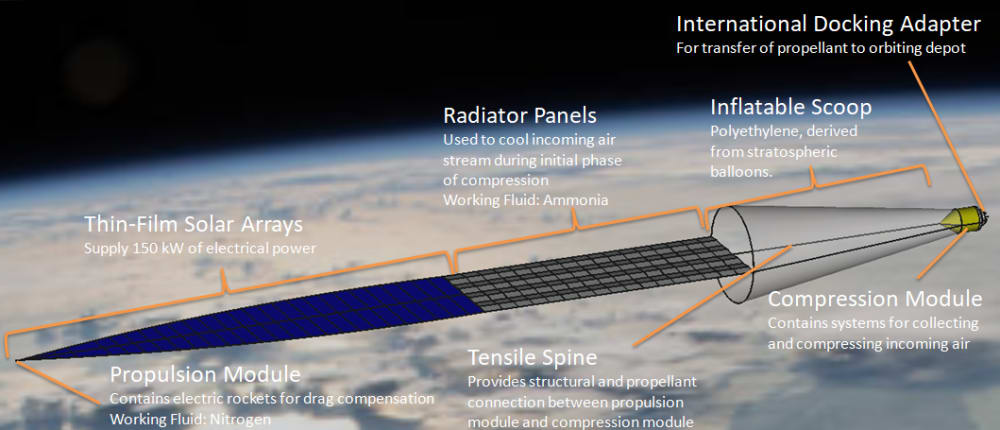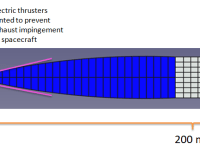

Despite its appearance as a barren, hard vacuum, Low Earth Orbit (LEO) has a very precious resource: Earth’s atmosphere. The atmosphere does not end at the official boundary of space (100 km) but grows increasingly rarified to an altitude well beyond that occupied by the International Space Station. At 180 km, there is a thin mixture of nitrogen, oxygen, and rarer elements. As liquid oxygen (LOX) and nitrogen tetroxide (N2O4), these elements constitute the majority of any deep-space mission’s initial propellant mass.
With a frontal area of 100 m2, a spacecraft orbiting at 180 km collides with 13,500 kg of oxygen and nitrogen every year. In current spacecraft, those gas molecules bounce off, robbing the spacecraft of momentum and eventually dragging it down to a fiery demise in Earth’s atmosphere. We propose to instead capture and store these gas molecules to supply spacecraft and space stations in Low Earth Orbit with propellant and breathing gas.
The collector spacecraft are designated “Pelican,” for their habit of descending into Earth’s atmosphere to collect sustenance. Each has a mass of 2,600 kilograms. This includes an inflatable ram scoop, electric thrusters to compensate for atmospheric drag and to change the spacecraft’s orbit, thin-film solar arrays to provide power, equipment to compress and liquefy incoming gas, and the spacecraft’s structural, thermal, communications, and control systems. The spacecraft are designed to be launched in groups of 8 inside the 5-meter fairing of a standard expendable launch vehicle.
In a single year of operation, each Pelican can collect 5.4 metric tons of LOX and 8 tons of liquid nitrogen (LN2). The incoming gasses are compressed by ram and reciprocating mechanical compression, and cryogenically processed until the incoming gas species condense. A combination of closed-loop radiators and cryocoolers and open-loop evaporative cooling by liquid nitrogen removes excess heat from the incoming air flow. A portion of the nitrogen is expended as propellant for the electric thrusters and for thermal control purposes.
The liquefied gasses collected by each Pelican can be used by the spacecraft itself to service other Low Earth Orbit satellites, docking with them to either extend their lifetimes or to de-orbit satellites at the end of their lives. Drawing their reaction mass from Earth’s atmosphere, Pelican spacecraft can change their orbital inclination with ease, servicing every Low Earth Orbit satellite market from polar-orbiting earth observation and internet service satellites to lower-inclination science platforms like the Hubble Space Telescope or International Space Station. In the longer term, Pelicans can service propellant depots in LEO, in turn fueling spacecraft bound for destinations beyond earth orbit.
A single launch of 8 Pelican spacecraft can collect over 43 ton of liquid oxygen per year. This represents LOX that does not need to be launched by additional boosters from Earth. A fleet of Pelicans can eliminate up to 80% of rocket launches required to support a mission beyond Earth orbit. By enabling in-situ resource utilization in Low Earth Orbit, Pelican converts that barren void into a springboard to the stars.
-
Awards
-
 2018 Aerospace & Defense Honorable Mention
2018 Aerospace & Defense Honorable Mention -
 2018 Top 100 Entries
2018 Top 100 Entries
Like this entry?
-
About the Entrant
- Name:Alex Dworzanczyk
- Type of entry:individual
- Software used for this entry:FreeCAD
- Patent status:none








